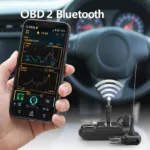OBD2 hyperterminal commands offer a powerful way to interact directly with your vehicle’s computer. This article dives deep into utilizing these commands for diagnostics, troubleshooting, and advanced vehicle control, providing you with the knowledge to unlock your car’s hidden data.
Understanding OBD2 and HyperTerminal
Before diving into specific commands, let’s establish a basic understanding of OBD2 and HyperTerminal. OBD2, or On-Board Diagnostics II, is a standardized system that allows external devices to access a vehicle’s diagnostic data. HyperTerminal, on the other hand, acts as a software interface, enabling your computer to communicate with the vehicle’s OBD2 port via a serial connection. This connection allows you to send obd2 hyperterminal commands directly to the vehicle’s ECU.
Essential OBD2 HyperTerminal Commands
Several key obd2 hyperterminal commands provide valuable insights into your vehicle’s performance. These commands are sent as hexadecimal codes and elicit specific responses from the ECU. Let’s explore some of the most commonly used commands:
- ATZ: This command resets the ECU and clears any existing communication errors. It’s often the first command used to establish a clean connection.
- ATE0/ATE1: Controls the echo function. ATE0 turns off the echo, while ATE1 turns it on. This determines whether the command sent is displayed back on the screen.
- ATL0/ATL1: Controls line feeds. Similar to the echo command, ATL0 disables line feeds and ATL1 enables them, affecting how the responses are formatted.
- ATH0/ATH1: Controls headers in responses. ATH0 disables headers while ATH1 enables them. Headers provide additional information about the response data.
- 010C: This command requests the supported PIDs (Parameter IDs). PIDs represent specific data points that can be accessed, such as engine RPM, coolant temperature, and fuel level.
Using OBD2 HyperTerminal Commands for Diagnostics
The real power of obd2 hyperterminal commands lies in their diagnostic capabilities. By sending specific commands, you can retrieve real-time data from the vehicle, allowing you to identify potential issues before they become major problems. For instance, monitoring the oxygen sensor readings (using specific PIDs) can help diagnose a faulty sensor or a lean/rich fuel mixture.
Advanced OBD2 HyperTerminal Techniques
Beyond basic diagnostics, obd2 hyperterminal commands can be used for more advanced tasks. Some of these include:
- Data Logging: By continuously polling specific PIDs, you can log data over time, allowing you to analyze trends and identify intermittent issues.
- Custom Scripting: Experienced users can create scripts to automate the sending and receiving of commands, streamlining the diagnostic process.
- Actuator Tests: Certain commands can activate specific actuators, such as fuel injectors or solenoids, allowing you to test their functionality directly.
Conclusion
Mastering obd2 hyperterminal commands opens a world of possibilities for vehicle diagnostics and control. By understanding these commands and their applications, you can unlock valuable insights into your vehicle’s performance and address potential issues proactively. While HyperTerminal itself is an older tool, the underlying principles and commands remain relevant in understanding OBD2 communication. Remember, always exercise caution when using these commands, as incorrect usage can potentially harm your vehicle’s systems.
FAQ
- What is the difference between OBD2 and OBD1? OBD2 is a standardized system, while OBD1 varied between manufacturers.
- Can I use any serial cable for OBD2 HyperTerminal connection? No, you need a specific OBD2 to serial adapter cable.
- Is HyperTerminal the only software I can use for obd2 hyperterminal commands? Other software options exist, but HyperTerminal is a common and readily available choice.
- What are some common errors I might encounter when using obd2 hyperterminal commands? Common errors include incorrect baud rate settings, communication errors, and unsupported PIDs.
- Where can I find a complete list of OBD2 PIDs? Numerous online resources and documentation provide comprehensive PID lists.
For further assistance, please contact us via WhatsApp: +1(641)206-8880, Email: [email protected] or visit us at 789 Elm Street, San Francisco, CA 94102, USA. Our 24/7 customer support team is ready to help.


